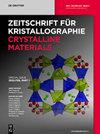Revisiting the structure of (±)-[Co(en)3]I3·H2O – X-ray crystallographic and second-Harmonic results
IF 2.7
4区 材料科学
Q3 CRYSTALLOGRAPHY
Zeitschrift Fur Kristallographie-Crystalline Materials
Pub Date : 2022-09-05
DOI:10.1515/zkri-2022-0044
引用次数: 0
Abstract
Abstract As described in the Introduction, we became interested in the existing literature for the crystallization behavior of (±)-[Co(en)3]I3·H2O and the absolute configuration of its enantiomers because of our project on the historical sequence of chemical studies leading Werner to formulate his Theory of Coordination Chemistry. In so doing, we discovered a number of interesting facts, including the possibility that the published “Pbca” structure of the (±)-[Co(en)3]I3·H2O was incorrect, and that it really crystallizes as a kryptoracemate in space group P212121. Other equally interesting facts concerning the crystallization behavior of [Co(en)3]I3·H2O are detailed below, together with an explanation why Platon incorrectly selects, in this case, the space group Pbca instead of the correct choice, P212121. As for the Flack parameter, (±)-[Co(en)3]I3·H2O provides an example long sought by Flack himself – a challenging case, differing from the norm. For that purpose, data sets (for the pure enantiomer and for the racemate) were collected at 100 K with R-factors of 4.24 and 2.82%, respectively, which are ideal for such a test. The fact that Pbca is unacceptable in this case is documented by the results of Second-Harmonic Generation experiments. CCDC nos: 1562401 for compound (I) and 1562403 for compound (II).对(±)-[Co(en)3]I3·H2O结构的修正——X射线晶体学和二次谐波结果
摘要如引言所述,由于我们对化学研究的历史序列进行了研究,导致Werner制定了他的配位化学理论,我们对现有文献中关于(±)-[Co(en)3]I3·H2O的结晶行为及其对映体的绝对构型产生了兴趣。在这样做的过程中,我们发现了许多有趣的事实,包括已发表的(±)-[Co(en)3]I3·H2O的“Pbca”结构可能是不正确的,并且它确实在P212121空间群中结晶为氪受体。关于[Co(en)3]I3·H2O结晶行为的其他同样有趣的事实在下面详细介绍,并解释为什么Platon在这种情况下错误地选择了空间群Pbca而不是正确的选择P212121。关于Flack参数,(±)-[Co(en)3]I3·H2O提供了Flack本人长期寻求的一个例子——一个具有挑战性的案例,与规范不同。为此,在100K下收集数据集(纯对映体和外消旋体的数据集),R因子分别为4.24%和2.82%,这对于这种测试来说是理想的。二次谐波产生实验的结果证明了在这种情况下Pbca是不可接受的。CCDC编号:化合物(I)1562401,化合物(II)1562403。
本文章由计算机程序翻译,如有差异,请以英文原文为准。
求助全文
约1分钟内获得全文
求助全文
来源期刊

Zeitschrift Fur Kristallographie-Crystalline Materials
CRYSTALLOGRAPHY-
CiteScore
2.00
自引率
16.70%
发文量
55
期刊介绍:
Zeitschrift für Kristallographie – Crystalline Materials was founded in 1877 by Paul von Groth and is today one of the world’s oldest scientific journals. It offers a place for researchers to present results of their theoretical experimental crystallographic studies. The journal presents significant results on structures and on properties of organic/inorganic substances with crystalline character, periodically ordered, modulated or quasicrystalline on static and dynamic phenomena applying the various methods of diffraction, spectroscopy and microscopy.
 求助内容:
求助内容: 应助结果提醒方式:
应助结果提醒方式:


